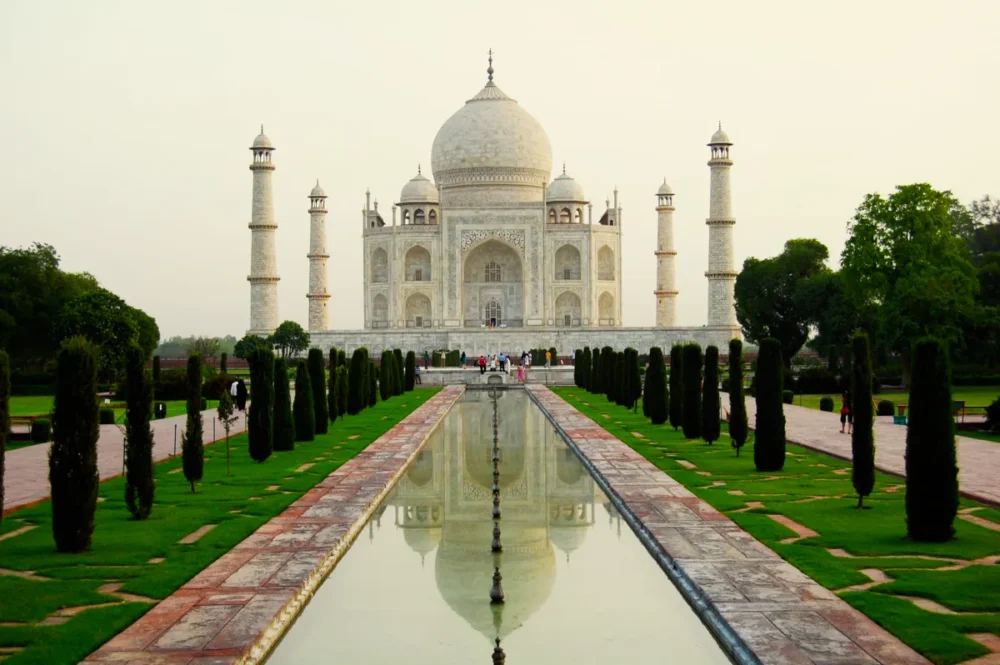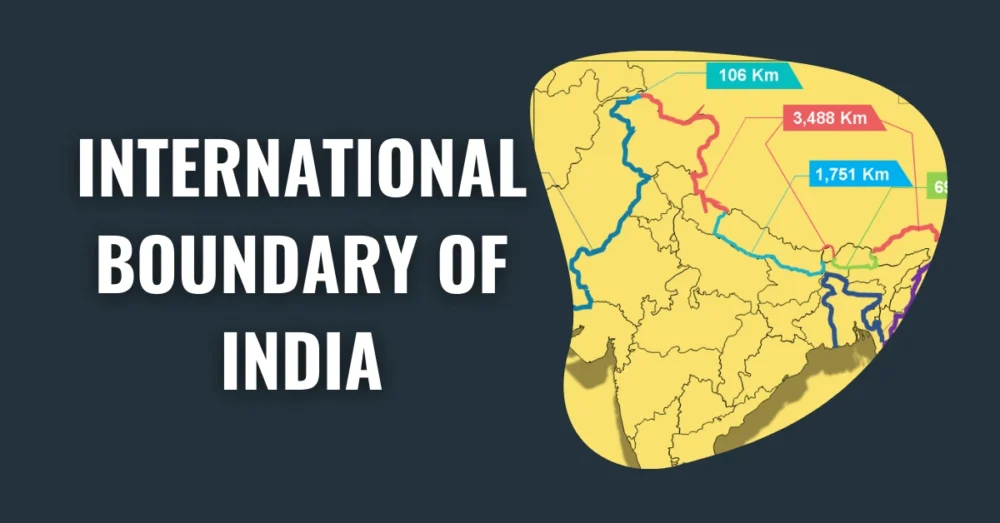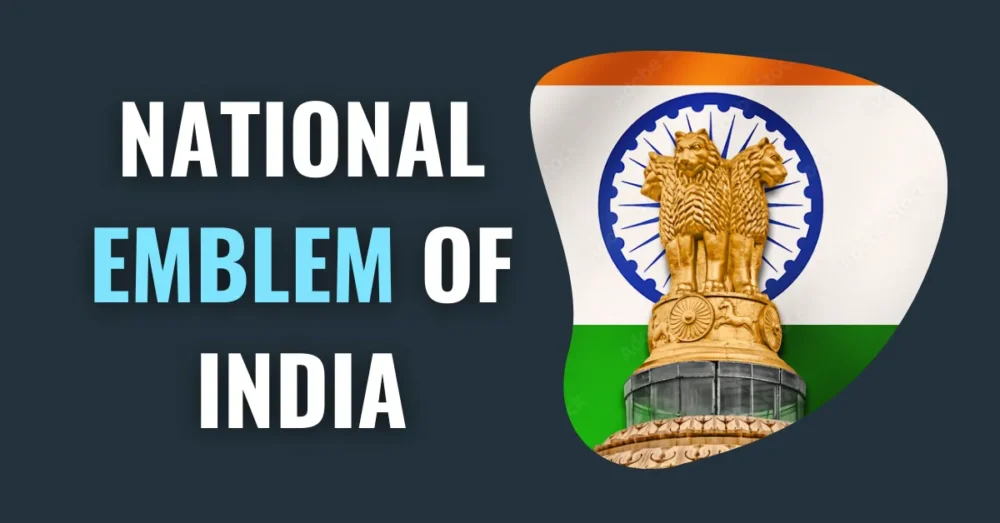The 20 Historical Monuments of India are landmarks that tell the story of India’s rich history, art, and architecture. These monuments reflect the country’s diverse culture and heritage. Some of these famous monuments are also listed as UNESCO World Heritage Sites, highlighting their global significance.
Learning about these historical monuments is crucial for competitive exams like SSC, UPSC, and NTPC, as they are an important part of the Art & Culture section in General Knowledge. In this article, we will explore the 20 most famous and historically significant monuments of India, along with some interesting GK facts.
What are the 20 Historical Monuments of India?
1. Taj Mahal, Agra
- The Taj Mahal is a white marble mausoleum located in Agra, Uttar Pradesh, India.
- It was built by Shah Jahan for his wife Mumtaz Mahal and also holds his tomb.
- Construction began in 1631 and was finished by 1648, though some parts took five more years.
- Made of white marble, with semi-precious stones and red sandstone for other buildings.
- More than 20,000 workers helped build it under Ustad Ahmad Lahori, the emperor’s architect.
- The Taj Mahal became a UNESCO World Heritage Site in 1983.
- It attracts over five million visitors each year and was named one of the New 7 Wonders of the World in 2007.

2. Red Fort, Delhi
- The Red Fort (Lal Qila) is a historic Mughal fort in Delhi, India.
- It was commissioned by Emperor Shah Jahan on 12 May 1639 when he moved the Mughal capital from Agra to Delhi.
- The fort’s design was by Ustad Ahmad Lahori, the same architect who designed the Taj Mahal.
- The fort features a mix of Persian palace style and Indian architectural traditions.
- During Nadir Shah’s invasion in 1739, the fort was looted, and many artworks and jewels were stolen.
- After the Indian Rebellion of 1857, most of the fort’s marble structures were destroyed by the British.
- The fort’s defensive walls remained largely intact and it became a garrison.
- On 15 August 1947, Jawaharlal Nehru, India’s first Prime Minister, raised the Indian flag at the Lahori Gate.
- Every Independence Day, the Prime Minister raises the flag at the fort and gives a national address.
- The Red Fort Complex was named a UNESCO World Heritage Site in 2007.
3. Jama Masjid, Delhi
- The Jama Masjid was built by Mughal emperor Shah Jahan between 1644 and 1656.
- It was inaugurated by Imam Syed Abdul Ghafoor Shah Bukhari.
- Located in the Mughal capital of Shahjahanabad (now Old Delhi), it served as the imperial mosque for the Mughal emperors until 1857.
4. Qutub Minar, Delhi
- The Qutb Minar is a minaret and victory tower located in the Qutb complex in Mehrauli, South Delhi, India.
- It stands on the site of Delhi’s oldest fortified city, Lal Kot, founded by the Tomar Rajputs.
- The construction of the Qutb Minar began in 1199 under Qutub-ud-din Aibak, who only completed the first level.
- The tower was completed between 1199 and 1220, with 399 steps, and is one of Delhi’s most visited heritage spots.
- Firuz Shah Tughlaq rebuilt the top parts of the tower in 1368 and added a cupola.
- The Qutb Minar is a UNESCO World Heritage Site and is often compared to the Minaret of Jam in Afghanistan.
- The Qutb Minar was illuminated for special events, including Mexico’s Independence Day (September 2023) and Turkey’s Republic Day (October 2023).
5. Ajanta Caves, Maharashtra
- The Ajanta Caves are 30 rock-cut Buddhist cave monuments located in the Aurangabad district of Maharashtra, India.
- These caves date from the second century BCE to 480 CE and are a UNESCO World Heritage Site.
- The caves are considered masterpieces of Buddhist religious art, with paintings and rock-cut sculptures that showcase emotions through gesture, pose, and form.
- The Ajanta Caves include ancient monasteries (Viharas) and worship halls (Chaityas) carved into a 75-meter (246 ft) rock wall.
- The paintings depict the past lives and rebirths of Buddha, along with tales from Aryasura’s Jatakamala and sculptures of Buddhist deities.
- The caves are believed to have served as a monsoon retreat for monks, and a resting place for merchants and pilgrims in ancient India.
- The caves were discovered in 1819 by British officer Captain John Smith while on a tiger-hunting expedition.
- The caves are situated on the northern wall of the U-shaped gorge of the Waghur River, in the Deccan Plateau, surrounded by waterfalls.
6. Ellora Caves, Maharashtra
- The Ellora Caves are a UNESCO World Heritage Site located in Aurangabad, India.
- It is one of the largest rock-cut Hindu temple cave complexes in the world, with artwork dating from 600–1000 AD. The complex also includes Buddhist and Jain caves.
- The complex features examples of Indian rock-cut architecture, with over 100 caves excavated from the basalt cliffs of the Charanandri Hills.
- Cave 16 houses the Kailash temple, the largest single monolithic rock excavation in the world. It is a chariot-shaped monument dedicated to Shiva.
- The Kailash temple features sculptures of Hindu deities and relief panels depicting major Hindu epics.
- There are 34 caves open to the public, including 17 Hindu caves (13–29), 12 Buddhist caves (1–12), and 5 Jain caves (30–34).
- The caves illustrate the religious harmony of ancient India, with monuments built during the Rashtrakuta dynasty (753-982 AD) and the Yadava dynasty (1187–1317).
- Funding for the monuments came from royals, traders, and the wealthy of the region.
- The caves served as temples and rest stops for pilgrims, and the site was also an important commercial centre on an ancient South Asian trade route.
- The Ellora Caves are located 29 km north-west of Aurangabad and 300 km east-northeast of Mumbai.
- Along with the Ajanta Caves, Ellora is a major tourist attraction in the Marathwada region of Maharashtra and is protected under the Archaeological Survey of India (ASI).
7. Hampi, Karnataka
- Hampi (also known as Hampe) is a UNESCO World Heritage Site located in Ballari district (now Vijayanagara district), Karnataka, India.
- Hampi predates the Vijayanagara Empire and is mentioned in the Ramayana and Puranas of Hinduism as Pampa Devi Tirtha Kshetra.
- It continues to be a religious centre, with the Virupaksha Temple, an Ādi Shankarāchārya-linked monastery, and various monuments.
- Hampi was the capital of the Vijayanagara Empire from 1336 to 1565 and was a fortified city.
- Persian and European travellers, especially from Portugal, described Hampi as a prosperous and grand city near the Tungabhadra River, with temples, farms, and trading markets.
- By 1500 CE, Hampi-Vijayanagara was the world’s second-largest city, after Beijing, and possibly India’s richest city at the time.
- The Vijayanagara Empire was defeated in 1565, and its capital was destroyed by Sultanate armies, leaving Hampi in ruins.
- The ruins of Hampi cover over 4,100 hectares (16 sq mi), and UNESCO describes it as an “austere, grandiose site”.
- The site includes 1,600+ surviving remains of the last great Hindu kingdom in South India, such as forts, temples, shrines, pillared halls, royal and sacred complexes, memorial structures, and water structures.
8. Mahabalipuram, Tamil Nadu
- Mamallapuram (also known as Mahabalipuram) is a town in Chengalpattu district, Tamil Nadu, southeastern India.
- It is famous for the UNESCO World Heritage Site of 7th- and 8th-century Hindu monuments.
- The town was historically known as Thirukadalmallai and is part of the Chennai Metropolitan Area.
- Mamallapuram was one of the two major port cities of the Pallava kingdom.
- It is named after Pallava king Narasimhavarman I, also known as Mamalla.
- The monuments include rathas (temples shaped like chariots), mandapas (cave sanctuaries), the Descent of the Ganges rock relief, and the Shore Temple dedicated to Shiva.
- The modern town plan was established by the British Raj in 1827.
9. India Gate (Delhi)
- India Gate is a war memorial in New Delhi, located near the Rajpath (now Kartavya Path).
- Built to honor 74,187 soldiers of the Indian Army who died in World War I and the Third Anglo-Afghan War.
- 13,300 names of soldiers, including some from the UK, are inscribed on the gate.
- Designed by Sir Edwin Lutyens, inspired by Roman triumphal arches like the Arch of Constantine and compared to the Arc de Triomphe in Paris.
- Beneath the archway is the Amar Jawan Jyoti, built in 1972 after the Bangladesh Liberation War, with a black marble plinth, reversed rifle, war helmet, and eternal flames.
- It is India’s largest war memorial and a key site for the Republic Day tribute by the Prime Minister.
10. Gateway of India (Mumbai, Maharashtra)
- Gateway of India is an arch-monument in Mumbai, completed in 1924 on the waterfront near Strand Road.
- Built to commemorate the 1911 visit of George V, the first British monarch to visit India.
- Foundation stone laid in March 1913; final design by George Wittet approved in 1914.
- Constructed in the Indo-Islamic style, inspired by 16th-century Gujarati architecture, using basalt.
- The arch is 26 meters (85 feet) high and resembles a triumphal arch.
- Served as a ceremonial entrance for government officials and was the point from where the last British troops left India in 1948.
- Located opposite the Taj Mahal Palace and Tower Hotel, overlooking the Arabian Sea.
- A popular tourist attraction, gathering spot for locals, street vendors, and photographers.
- Site for Hanukkah celebrations since 2003, with the lighting of the menorah.
- In March 2019, the Maharashtra Government proposed a plan to develop the location for tourist convenience.
11. Mysore Palace (Mysore, Karnataka)
- Mysore Palace, also called Amba Vilas Palace, is a historical palace and royal residence in Mysore, Karnataka.
- It was the official residence of the Wadiyar dynasty and the seat of the Kingdom of Mysore.
- Located in the centre of Mysore, it faces the Chamundi Hills to the east.
- Mysore is called the ‘City of Palaces’ and has seven palaces, including this one.
- The palace site was originally called Mysuru (meaning citadel).
- The first palace was built in the 14th century, but it was burnt down and rebuilt several times.
- The current structure (also known as the New Fort) was constructed between 1897 and 1912 after the Old Palace was destroyed by fire.
- Built using stone, bricks, and wood, unlike the earlier wooden fort.
- It is one of India’s most famous tourist attractions, second only to the Taj Mahal, with over three million visitors annually (as of 2014).
12. Fatehpur Sikri (Agra, Uttar Pradesh)
- Fatehpur Sikri is a town in the Agra District of Uttar Pradesh, located 35.7 km from Agra.
- It was founded as the capital of the Mughal Empire in 1571 by Emperor Akbar.
- Served as the capital until 1585, when Akbar abandoned it due to a campaign in Punjab, and was fully abandoned by 1610.
- Named after the village Sikri, which previously existed at the site.
- Archaeological excavations revealed earlier settlements, including housing, temples, and commercial centres.
- The region was previously controlled by Sungas and later by Sakarwar Rajputs until the Battle of Khanwa (1527).
- The khanqah of Sheikh Salim Chishti existed here, and Akbar’s son Jahangir was born in Sikri in 1569.
- Akbar built a religious compound and later a walled city to commemorate Sheikh Salim Chishti’s prediction of Jahangir’s birth.
- Renamed Fatehpur Sikri or “City of Victory” after Akbar’s Gujarat campaign victory in 1573.
- Became an administrative centre under the East India Company from 1803 to 1850.
- Monuments were repaired in 1815 by the Marquess of Hastings.
- Designated as a UNESCO World Heritage Site in 1986 for its historical importance and exceptional architecture.
13. Hawa Mahal (Jaipur, Rajasthan)
- Hawa Mahal, or the “Palace of Winds”, is located in Jaipur, Rajasthan.
- Built in 1799 by Maharaja Sawai Pratap Singh, it is made of red and pink sandstone.
- Inspired by the design of Khetri Mahal, it was designed by Lal Chand Ustad.
- Features 953 small windows called Jharokhas, forming a honeycomb-like exterior.
- The lattice design allowed royal women to observe street life and festivals while remaining unseen.
- The design also created a cooling Venturi effect, making it comfortable during summers.
- The five-floor structure is often mistaken as the front but is actually the back of the palace.
- Unit Trust of India adopted Hawa Mahal for its preservation.
- Popular tourist features include stone-carved screens, small casements, arched roofs, and hanging cornices.
14. Victoria Memorial (Kolkata, West Bengal)
- Victoria Memorial is a large marble monument located on the Maidan in Central Kolkata.
- Built between 1906 and 1921 by the British Raj, it honors Queen Victoria, Empress of India (1876–1901).
- It is the largest monument to a monarch in the world.
- The memorial spans 64 acres of gardens and is now a museum under the Ministry of Culture, Government of India.
- Features Indo-Saracenic architecture and is a popular tourist attraction in Kolkata.
15. Brihadeeswarar Temple (Thanjavur, Tamil Nadu)
- Brihadishvara Temple, also called Rajarajesvaram or Thanjai Periya Kovil, is a Shaivite Hindu temple located in Thanjavur, Tamil Nadu, on the south bank of the Cauvery River.
- Built by Chola emperor Rajaraja I between 1003 and 1010 CE, it showcases Chola architectural style and is part of the UNESCO World Heritage Site “Great Living Chola Temples”.
- Known as Dakshina Meru (Meru of the South), it is one of the largest Hindu temples and a prominent example of Tamil architecture.
- The temple features a massive vimana tower, colonnaded prakara (corridor), and one of the largest Shiva lingas in India.
- Renowned for its granite construction, intricate sculptures, and brass Nataraja commissioned in the 11th century, it also houses shrines for Nandi, Parvati, Murugan, Ganesha, and others.
- A major tourist attraction in Tamil Nadu, the temple is celebrated for its historical, architectural, and religious significance.
16. Rani ki Vav (Patan, Gujarat)
- Rani Ki Vav (Queen’s Stepwell) is a UNESCO World Heritage Site located in Patan, Gujarat, on the banks of the Saraswati River.
- Built in the 11th century, its construction is credited to Udayamati, the queen of Chaulukya king Bhima I.
- The stepwell was silted over and rediscovered in the 1940s, with restoration completed in the 1980s by the Archaeological Survey of India.
- Designed as an inverted temple, it emphasizes the sanctity of water and features seven levels of stairs adorned with sculptural panels.
- The stepwell boasts over 500 principal sculptures and 1000 minor carvings, blending religious, secular, and symbolic imagery.
17. Sanchi Stupa (Sanchi, Madhya Pradesh)
- Sanchi Stupa is a Buddhist complex in Sanchi Town, Raisen District, Madhya Pradesh, India.
- Located 23 km from Raisen town and 46 km from Bhopal, the capital of Madhya Pradesh.
- The Great Stupa at Sanchi is one of the oldest stone structures in India.
- It was commissioned by Emperor Ashoka in the 3rd century BCE.
- The stupa’s original structure was a hemispherical brick building over the relics of Buddha.
- Chatra, a parasol-like structure, was placed on top to honor the relics.
- Ashoka oversaw the construction, and his wife, Devi, was from Vidisha.
- In the 1st century BCE, 4 carved gateways (toranas) and a balustrade were added.
- The stupa was originally made of bricks and flourished until the 11th century.
- Sanchi is the center of a region with many other stupas, like Satdhara, Bhojpur, Andher, and Sonari.
- Sanchi Stupa is featured on the reverse side of the Indian ₹200 currency note.
18. Kumbhalgarh Fort (Rajasthan)
- Kumbhalgarh is a fortress in the Aravalli Hills of Rajsamand district, Rajasthan, India.
- It is located about 48 km from Rajsamand city and 84 km from Udaipur.
- Built in the 15th century by Rana Kumbha.
- The Kumbhalgarh wall is one of the longest continuous walls in the world, stretching 38 km.
- It is the birthplace of Maharana Pratap, a great king and military leader of Mewar.
- In 2013, Kumbhalgarh Fort was declared a UNESCO World Heritage Site as part of the Hill Forts of Rajasthan.
19. Konark Sun Temple (Konark, Odisha)
- Konark Sun Temple is a 13th-century Hindu temple located 35 km from Puri city, Odisha, India.
- Built around 1250 CE by King Narasingha Deva I of the Eastern Ganga dynasty.
- Dedicated to the Hindu Sun-god Surya, the temple resembles a 100-foot-high chariot with stone-carved wheels and horses.
- Originally over 200 feet high, much of the temple is now in ruins, especially the large shikara tower.
- The surviving structures are famous for their intricate artwork, including erotic kama and mithuna scenes.
- The temple is a classic example of Odisha or Kalinga architecture.
- The cause of the temple’s destruction is unclear, with theories ranging from natural damage to deliberate destruction by Muslim armies in the 15th to 17th centuries.
- It was known as the “Black Pagoda” by European sailors in the 17th century.
- The Jagannath Temple in Puri was referred to as the “White Pagoda“.
- The temple was partially restored during British India archaeological efforts.
- UNESCO World Heritage Site since 1984.
- It is a major pilgrimage site, especially during the Chandrabhaga Mela in February.
- Depicted on the reverse side of the Indian ₹10 currency note.
20. Nalanda University Ruins (Nalanda, Bihar)
- Nalanda was a renowned Buddhist monastery in ancient Magadha (modern-day Bihar), India.
- It is often called “the world’s first residential university” and was one of the greatest centers of learning in the ancient world.
- Established by Emperor Kumaragupta I of the Gupta Empire around 427 CE.
- Supported by various patrons, including Indian and Javanese Buddhists and non-Buddhists.
- Thrived under the rulers of the Pala Empire (750–1161 CE) and later by the Pithipatis of Bodh Gaya.
- Muhammad Bakhtiyar Khilji attacked and burned Nalanda around 1200 CE, but it continued to function for years.
- Faculty included scholars like Dharmapala, Nagarjuna, Xuanzang, and Vajrabodhi.
- The curriculum included Mahayana Buddhism, Vedas, medicine, astronomy, mathematics, and more.
- Nalanda’s library was key in transmitting Sanskrit texts to East Asia.
- Texts from Nalanda contributed to Mahayana and Vajrayana Buddhism.
- Declared a UNESCO World Heritage Site.
- In 2010, Nālandā University was established in Rajgir, reviving the ancient institution.
Conclusion
Important monuments of India showcase the country’s rich art and architecture. These historical sites are not only popular tourist attractions but also offer valuable insights into India’s traditional culture and history.
Affairshub offers detailed notes for various competitive exams. It is a top choice for students because it provides high-quality resources on general knowledge and current affairs.






